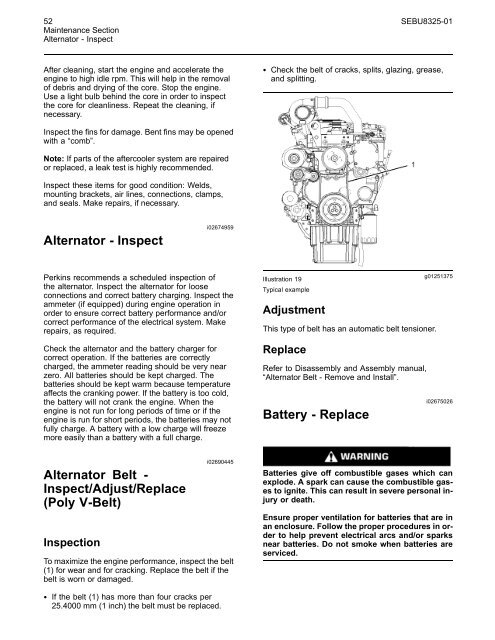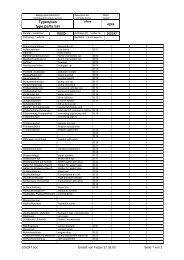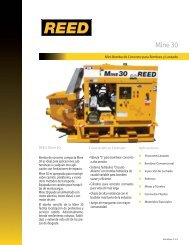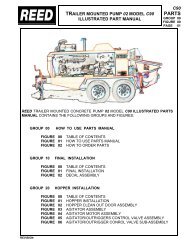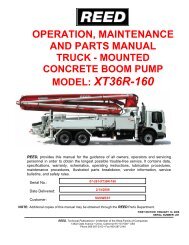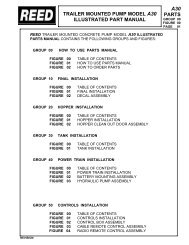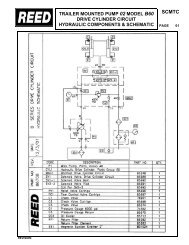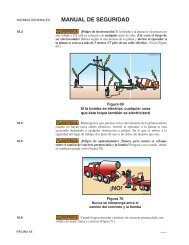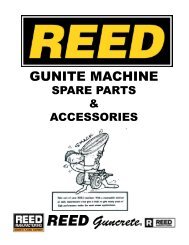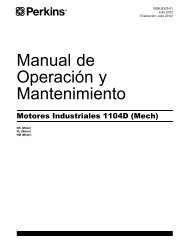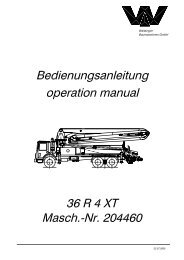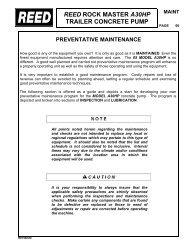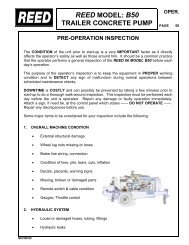Perkins Motor Operation and Maintenance Manual (English) - REED
Perkins Motor Operation and Maintenance Manual (English) - REED
Perkins Motor Operation and Maintenance Manual (English) - REED
You also want an ePaper? Increase the reach of your titles
YUMPU automatically turns print PDFs into web optimized ePapers that Google loves.
52 SEBU8325-01<br />
<strong>Maintenance</strong> Section<br />
Alternator - Inspect<br />
After cleaning, start the engine <strong>and</strong> accelerate the<br />
engine to high idle rpm. This will help in the removal<br />
of debris <strong>and</strong> drying of the core. Stop the engine.<br />
Use a light bulb behind the core in order to inspect<br />
the core for cleanliness. Repeat the cleaning, if<br />
necessary.<br />
• Check the belt of cracks, splits, glazing, grease,<br />
<strong>and</strong> splitting.<br />
Inspect the fins for damage. Bent fins may be opened<br />
with a “comb”.<br />
Note: If parts of the aftercooler system are repaired<br />
or replaced, a leak test is highly recommended.<br />
Inspect these items for good condition: Welds,<br />
mounting brackets, air lines, connections, clamps,<br />
<strong>and</strong> seals. Make repairs, if necessary.<br />
Alternator - Inspect<br />
i02674959<br />
<strong>Perkins</strong> recommends a scheduled inspection of<br />
the alternator. Inspect the alternator for loose<br />
connections <strong>and</strong> correct battery charging. Inspect the<br />
ammeter (if equipped) during engine operation in<br />
order to ensure correct battery performance <strong>and</strong>/or<br />
correct performance of the electrical system. Make<br />
repairs, as required.<br />
Check the alternator <strong>and</strong> the battery charger for<br />
correct operation. If the batteries are correctly<br />
charged, the ammeter reading should be very near<br />
zero. All batteries should be kept charged. The<br />
batteries should be kept warm because temperature<br />
affects the cranking power. If the battery is too cold,<br />
the battery will not crank the engine. When the<br />
engine is not run for long periods of time or if the<br />
engine is run for short periods, the batteries may not<br />
fully charge. A battery with a low charge will freeze<br />
more easily than a battery with a full charge.<br />
Illustration 19<br />
Typical example<br />
Adjustment<br />
This type of belt has an automatic belt tensioner.<br />
Replace<br />
Refer to Disassembly <strong>and</strong> Assembly manual,<br />
“Alternator Belt - Remove <strong>and</strong> Install”.<br />
Battery - Replace<br />
g01251375<br />
i02675026<br />
Alternator Belt -<br />
Inspect/Adjust/Replace<br />
(Poly V-Belt)<br />
Inspection<br />
i02690445<br />
To maximize the engine performance, inspect the belt<br />
(1) for wear <strong>and</strong> for cracking. Replace the belt if the<br />
belt is worn or damaged.<br />
Batteries give off combustible gases which can<br />
explode. A spark can cause the combustible gases<br />
to ignite. This can result in severe personal injury<br />
or death.<br />
Ensure proper ventilation for batteries that are in<br />
an enclosure. Follow the proper procedures in order<br />
to help prevent electrical arcs <strong>and</strong>/or sparks<br />
near batteries. Do not smoke when batteries are<br />
serviced.<br />
• If the belt (1) has more than four cracks per<br />
25.4000 mm (1 inch) the belt must be replaced.


